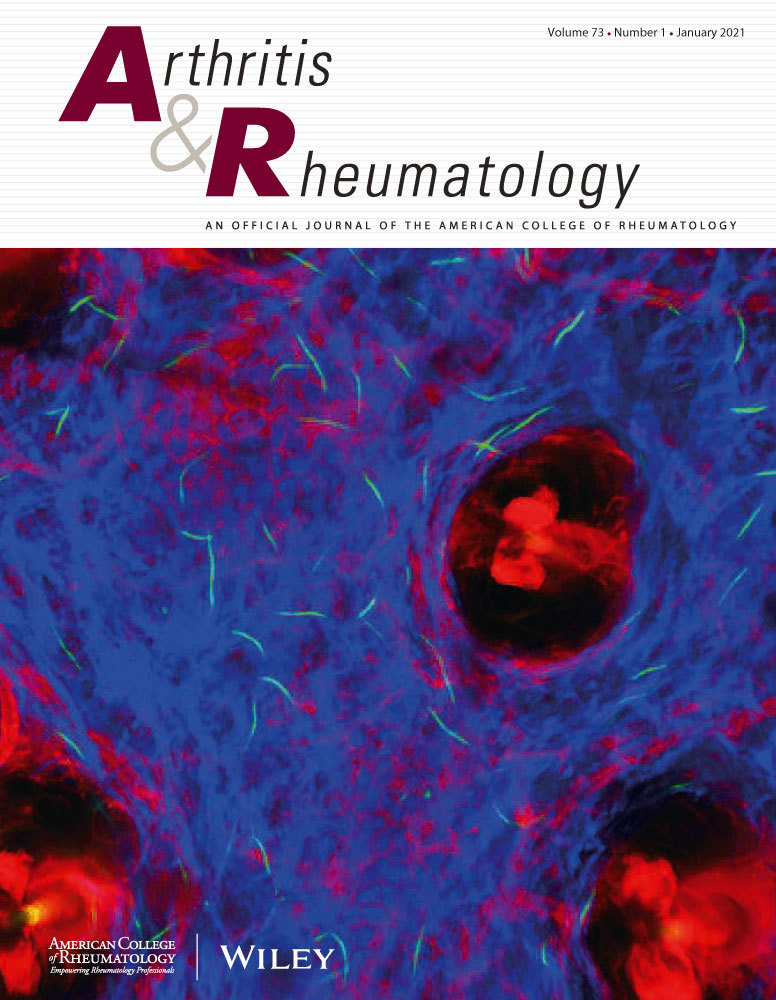Late-Onset Spondylarthritis Presenting as Glucocorticoid-Resistant Polymyalgia Rheumatica: A hitherto underappreciated entity where TNF or IL-17 Blockade may have a Therapeutic Role.
IF 10.9
1区 医学
Q1 RHEUMATOLOGY
引用次数: 0
Abstract
BACKGROUND Polymyalgia rheumatica (PMR) is an age-related inflammatory disease with shoulder-hip girdle involvement. Magnetic resonance imaging (MRI) reveals extracapsular/entheseal soft tissue involvements in both PMR and spondyloarthritis (SpA) with sacroiliac joint and peri-entheseal spinal bone marrow oedema (BMO) being characteristic of SpA. Therefore, some shared anatomical topography might be expected to result in similar clinical features. Herein we describe the clinical and imaging features of SpA initially diagnosed as PMR. METHODS Patients followed at Leeds Teaching Hospitals NHS Trust with a diagnosis of psoriatic arthritis (PsA), or axial SpA (axSpA) were screened to identify those initially diagnosed with PMR from 2002 to 2024. Only those patients who retrospectively fulfilled the 2012 EULAR/ACR classification criteria or the Bird criteria for PMR were included. Clinical data relevant to initial PMR diagnosis, imaging features, follow-up and treatment data were collected, as well as radiographic or MRI features that established the final diagnosis. RESULTS Thirty-one patients [median age in years (IQR): 62 (58-69); 17 females and 14 males] presenting with typical PMR shoulder/hip girdle pain were subsequently classified as SpA-spectrum disorders. The SpA diagnosis was made in 12 patients within three months of presentation, and in 19 patients during the remaining follow-up period [median (IQR): 3 (1-4) years]. Four of 27 tested patients were HLA-B27 positive. BMO on MRI was detected in the spine and/or sacroiliac joints in 20 of 25 imaged patients (80%) (sacroiliac joint: 17 patients [68%], spine: 15 patients [60%]). Clinical resolution with CRP normalisation occurred in 21 of 31 patients following initial glucocorticoid (GC) therapy, but 7 of these 21 initial responders experienced disease flares or CRP elevations. Therapy-wise, disease-modifying antirheumatic drugs (DMARDs) were used in 21 of 31 cases: 8 received conventional DMARDs, and 11 received biologic agents (eight anti-TNFs, three IL-17 inhibitors), while the remaining 10 patients were treated with 10 mg/day or less GC therapy. CONCLUSION Late-onset SpA with PMR clinical presentations is characterised by failure to respond to or taper GC therapy and is often identified by SpA-specific osteitis patterns on MRI. We propose that a PMR-SpA overlap may account for biological therapy efficacy in steroid-refractory PMR.迟发性脊柱炎表现为糖皮质激素抵抗性风湿性多肌痛:迄今为止未被充分认识的实体,TNF或IL-17阻断可能具有治疗作用。
背景:风湿性多肌痛(PMR)是一种累及肩臀带的年龄相关性炎症性疾病。磁共振成像(MRI)显示PMR和脊椎关节炎(SpA)的囊外/骨髓膜软组织受累,骶髂关节和骨髓膜周围脊髓水肿(BMO)是SpA的特征。因此,一些共同的解剖地形可能会导致相似的临床特征。在此,我们描述了最初诊断为PMR的SpA的临床和影像学特征。方法对2002年至2024年期间在利兹教学医院NHS信托医院诊断为银屑病关节炎(PsA)或轴向SpA (axSpA)的患者进行筛选,以确定最初诊断为PMR的患者。仅纳入回顾性符合2012年EULAR/ACR分类标准或Bird PMR标准的患者。收集与PMR初始诊断、影像学特征、随访和治疗相关的临床资料,以及确定最终诊断的x线或MRI特征。结果31例患者[中位年龄(IQR): 62 (58 ~ 69);17名女性和14名男性]表现为典型的PMR肩/臀带疼痛,随后被归类为spa谱系障碍。12例患者在出现后3个月内进行了SpA诊断,19例患者在剩余的随访期间进行了SpA诊断[中位(IQR): 3(1-4)年]。27例检测患者中有4例HLA-B27阳性。25例MRI成像患者中有20例(80%)在脊柱和/或骶髂关节发现BMO(骶髂关节:17例(68%),脊柱:15例(60%))。在接受初始糖皮质激素(GC)治疗后,31例患者中有21例出现CRP正常化的临床缓解,但这21例初始应答者中有7例出现疾病发作或CRP升高。在治疗方面,31例患者中有21例使用了改善疾病的抗风湿药物(DMARDs): 8例接受常规DMARDs, 11例接受生物制剂(8例抗tnf, 3例IL-17抑制剂),其余10例患者接受10mg /天或更少的GC治疗。结论迟发性SpA伴PMR临床表现的特点是对GC治疗无效或逐渐减少,并且通常在MRI上通过SpA特异性骨炎模式来识别。我们提出PMR- spa重叠可能解释了类固醇难治性PMR的生物治疗效果。
本文章由计算机程序翻译,如有差异,请以英文原文为准。
求助全文
约1分钟内获得全文
求助全文
来源期刊

Arthritis & Rheumatology
RHEUMATOLOGY-
CiteScore
20.90
自引率
3.00%
发文量
371
期刊介绍:
Arthritis & Rheumatology is the official journal of the American College of Rheumatology and focuses on the natural history, pathophysiology, treatment, and outcome of rheumatic diseases. It is a peer-reviewed publication that aims to provide the highest quality basic and clinical research in this field. The journal covers a wide range of investigative areas and also includes review articles, editorials, and educational material for researchers and clinicians. Being recognized as a leading research journal in rheumatology, Arthritis & Rheumatology serves the global community of rheumatology investigators and clinicians.
 求助内容:
求助内容: 应助结果提醒方式:
应助结果提醒方式:


